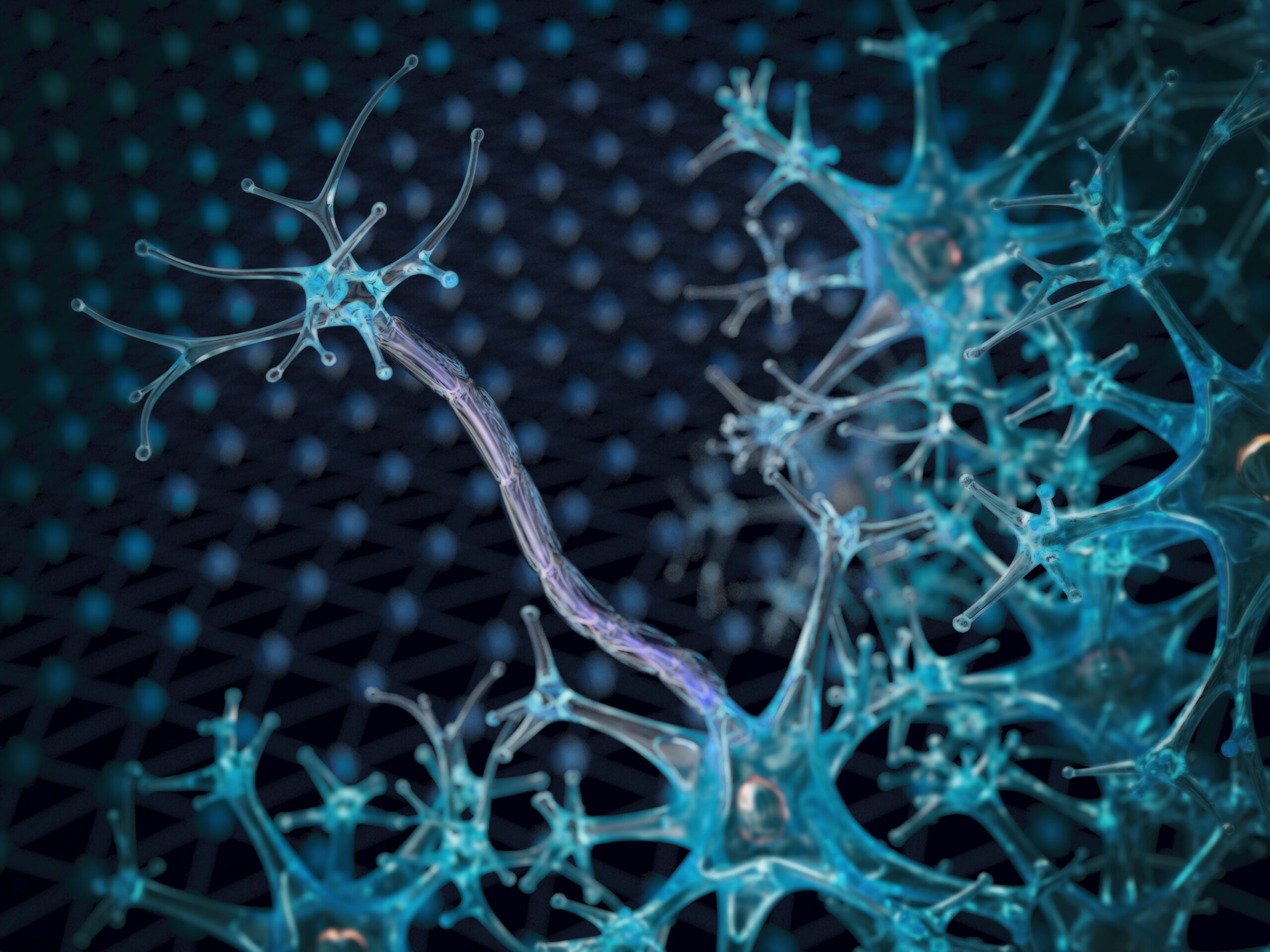What is the current state of knowledge regarding health effects of radiofrequency electromagnetic fields (RF-EMF)? Is there or is there not a statistical relationship between the prevalence of brain tumors and RF EMF exposure? What are the recommendations for dealing with electromagnetic hypersensitivity?
Despite the widespread use of wireless communication technologies, there is a high level of unease among the general public regarding potential health consequences. In the recurring representative surveys within the framework of the “Mobilfunkmonitor”, about 50-60% of the respondents believe in negative health effects of mobile radio or state that they have already experienced such effects. This proportion has hardly changed since 2003. With the imminent introduction of the 5G “New Radio” mobile communications standard (box), the question of possible health effects of radiofrequency electromagnetic fields (RF-EMF) is once again increasingly in the public eye.
RF-EMF exposure in everyday life
HF-EMF are not perceptible. Therefore, little is known about how much we are actually exposed in everyday life. A distinction is made here between devices operated close to the body, such as mobile and cordless phones, and sources of radiation remote from the body, such as mobile phone base stations or radio and TV antennas. For the former, the specific absorption rate (SAR) is the relevant exposure parameter, for environmental exposures the electric field strength in volts per meter. Accordingly, there are also different limits for situations in which the whole body is irradiated and situations in which only a part of the body is locally affected (Fig. 1).
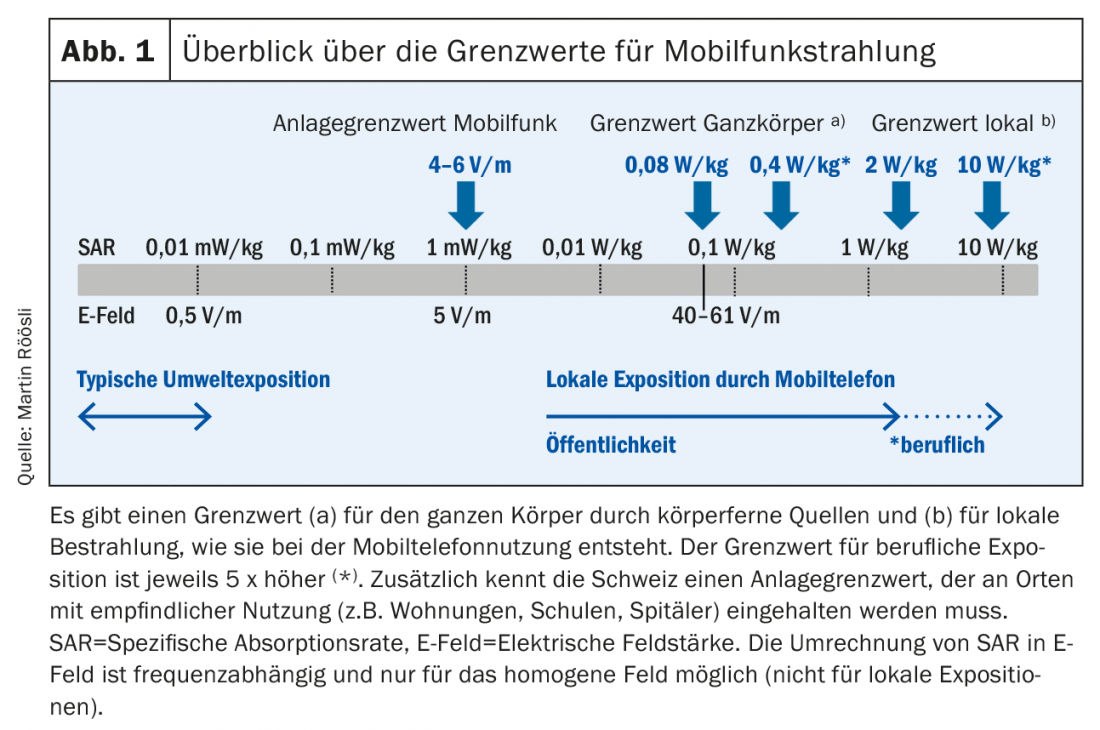
Emissions from mobile and cordless phones
Cell phones have power control. The difference between maximum and minimum radiated power can be a factor of 100’000 depending on the connection quality and system. In urban areas, the transmission power of cell phones is therefore lower on average than in rural areas because of the denser antenna network [1]. However, cell phones not only emit radiation when they are in use, but also when they are on standby to maintain connectivity and continuously update applications installed on the smartphone.
The maximum emission of cordless phones is lower than that of cell phones by a factor of 10. However, most cordless phones do not have power control, so the average radiation exposure during a phone call can be similar to that of a cell phone.
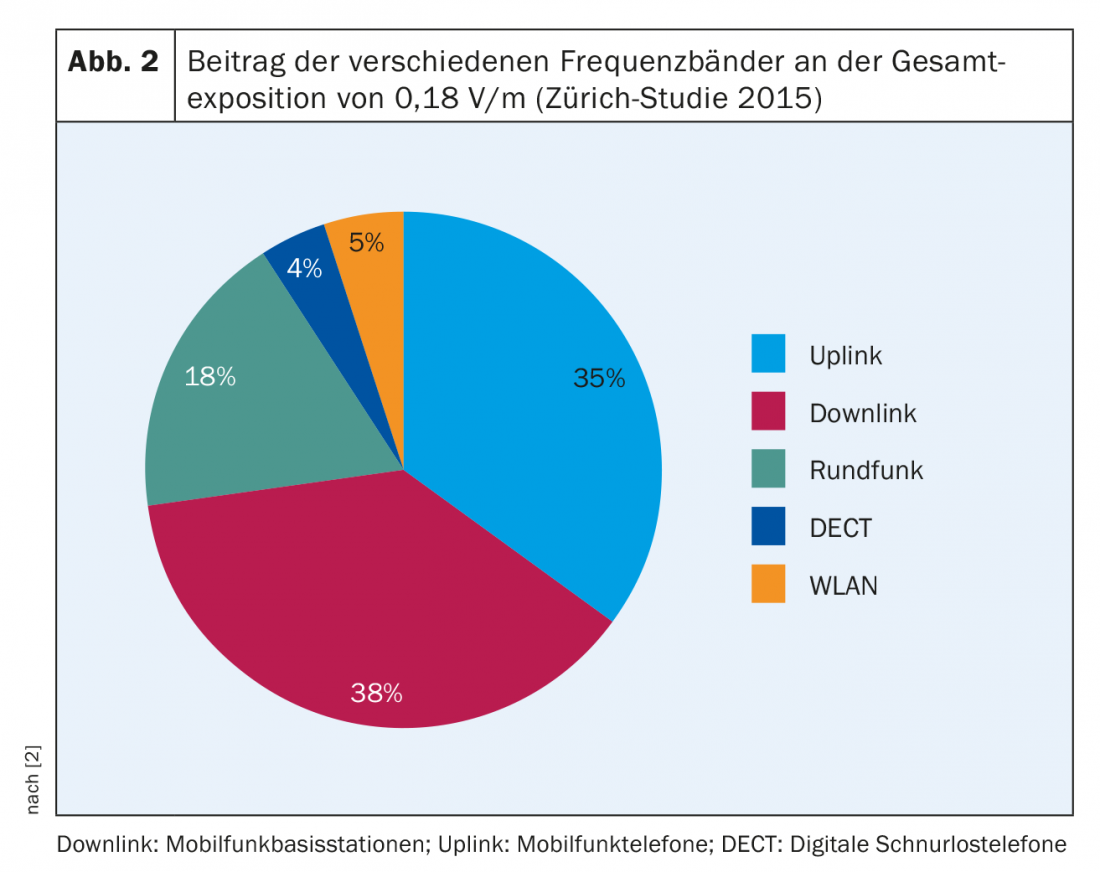
HF-EMF in the environment
Everyday RF-EMF exposure from sources remote from the body was last surveyed in Switzerland in 2015 in 115 randomly selected individuals from the canton of Zurich [2]. Adolescents (ages 12-15) and their parents and young adults (ages 18-30) from twelve communities representing the full range from rural to urban were selected for study participation. Study participants carried a portable meter (ExpoM-RF) for 48-72 hours that recorded a reading every four seconds for twelve frequency bands ranging from FM radio (87.5 MHz) to LTE cellular base stations (2690 MHz) and the GPS coordinates of their location. The study participants also kept an activity diary. The mean measured personal exposure in the study population was 0.18 V/m (maximum value: 0.42 V/m) (Fig. 1), with the main contributions coming from cell phone base stations (downlink: 38%) and from cell phones (uplink: 35%). Less relevant were radio (18%), WLAN (5%), and cordless phones (4%) (Fig. 2) . On average, RF-EMF exposure was highest in public transport. The lowest values were measured in schools and at home. Differences between rural and urban areas were relatively small. However, the downlink tended to increase with increasing urbanicity (Fig. 3).
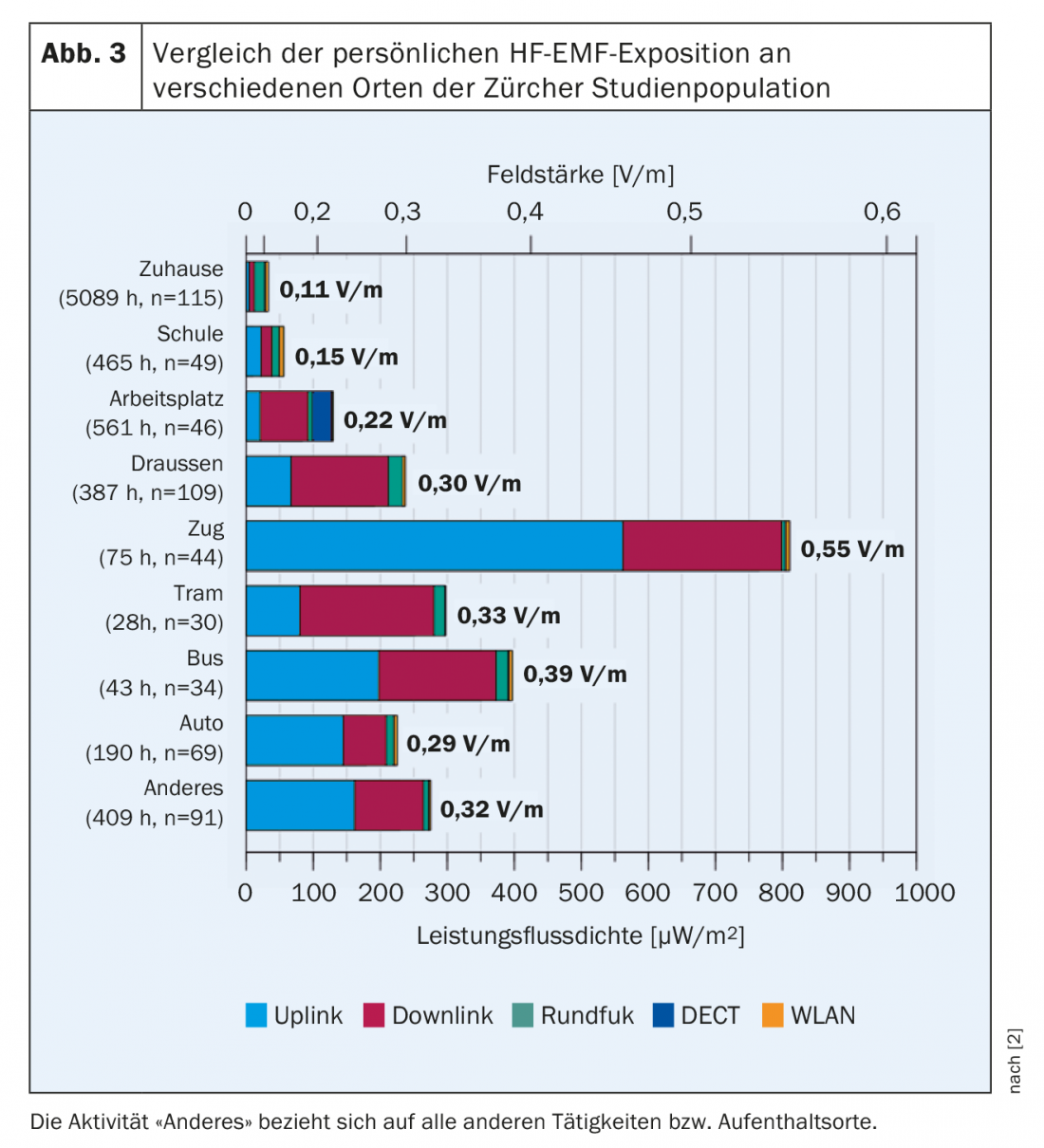
Figure 4 shows a comparison of the personal mean RF-EMF exposure of adults in the Zurich measurement study [2] with the measured exposure in the QUALIFEX study [3], which was conducted with similar methodology in the Basel region in 2007/2008. The mean RF EMF exposure was 0.22 V/m in QUALIFEX and 0.18 V/m in the Zurich measurement study. Previously, the contribution from DECT cordless phones and cell phones in particular was higher than in the Zurich measurement study. This shows that increasing use of wireless communication devices does not necessarily mean an increase in RF EMF exposure, as this can be compensated with higher efficiency and improved power control.
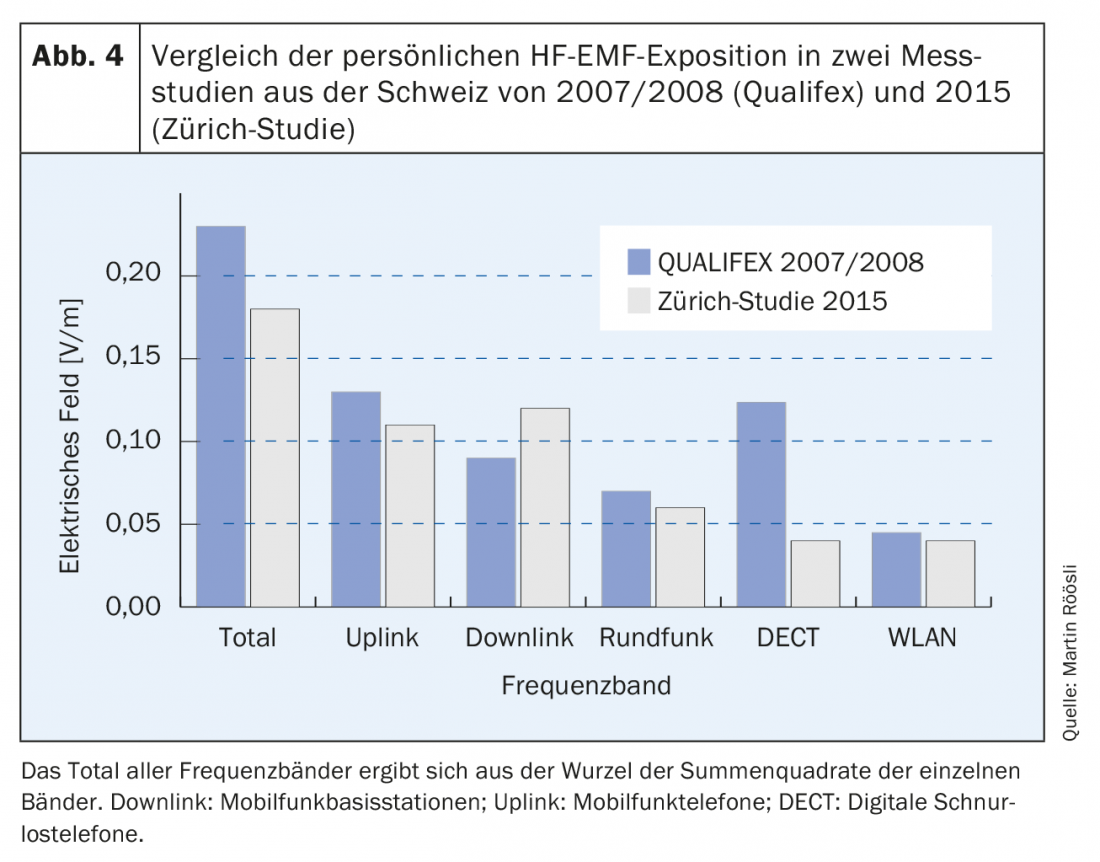
Contribution of cell phones and base stations to the cumulative dose
RF EMF decreases sharply with increasing distance from the source: doubling the distance to the emitting source leads to a halving of the field strength. Therefore, a cell phone at the ear irradiates the head about 1000 to 100,000 times more than the usual environmental sources [4]. However, the exposure duration is generally less for devices operated close to the body. An estimation of the contributions of the different RF EMF sources to the cumulative absorbed RF EMF dose of the brain and the whole body based on the Zurich EMF measurement study showed that for the brain, 96% of the total dose of about 600 mJ per day and per kilogram of body weight originates from devices operated close to the body (Fig.5). Cell phone calls are the most relevant, contributing 78% to the cumulative dose. Sources remote from the body contribute minimally to brain dose (4%). Also, with respect to the whole-body dose of about 200 mJ/kg/day, sources remote from the body contribute only 10%. In this context, about 5% of the total RF EMF dose originates from mobile phone base stations.

Health effects due to RF-EMF
In vitro and in vivo studies found partial effects of RF-EMF on brain blood flow and metabolism, apoptosis, reactive oxygen species (ROS), and gene and protein expression [5]. Studies in humans found influences on brain waves and cognitive functions. Such effects have been observed at exposures such as those that may occur when using a cell phone on the head or at higher exposures, but not at weaker environmental exposures. How and whether these biological effects affect long-term health is still unclear.
Tumors in the head area
Because the head is most exposed, epidemiologic research on the carcinogenicity of RF-EMF has focused on tumors of the head. Sporadically, increased risks for gliomas or acoustic neuromas have been observed in case-control studies with intensive cell phone use. That is why the International Agency for Research on Cancer (IARC) classified HF-EMF as possibly carcinogenic (Group 2B) in 2011 [6]. However, a new meta-analysis of all studies published by the end of 2017 finds no association between cell phone use and gliomas, meningiomas, and acoustic neuromas, and for tumors of the pituitary gland or salivary glands [7]. Since 50% of all Europeans were already using a cell phone in 2000, any tumor risk should ultimately also manifest itself in an increase in new cases. This has not been seen in recent evaluations of cancer registry data from Scandinavia, England, or the United States [7]. Thus, a strongly increased risk due to cell phone use, as reported in individual studies, can be excluded. Thus, any risk of disease is relatively low, affects only certain histological tumor forms, or manifests only after a long latency period (>15) years.
Health complaints due to “electrosmog
In connection with EMF, complaints such as headaches, sleep or concentration disorders are most frequently brought up in the doctor’s office [8]. Those affected then often speak of the possible trigger “electrosmog,” which can include both low-frequency and high-frequency fields and usually refers to sources far from the body. This is called electromagnetic hypersensitivity or idiopathic environmental intolerance attributed to EMF.
A large number of experimental studies have investigated the acute onset of symptoms under double-blind and randomized conditions. The vast majority of these studies found no evidence of an effect by RF-EMF [9]. There were also no indications that there are persons who are particularly sensitive to EMF or who can perceive such fields, as is often described by those affected [10,11]. These provocation studies found strong evidence for nocebo effects in return. When subjects were convinced or, in the case of openly declared provocations, knew they were exposed, significantly more and more severe symptoms occurred. Also, in most epidemiological studies with methodologically good exposure assessment, no long-term impairment of well-being by RF-EMF sources far from the body was observed. However, many studies show a negative correlation between the duration of cell phone use and well-being. However, in-depth clarifications indicate that this is not due to RF-EM exposure, but to other aspects of cell phone use or methodological shortcomings.
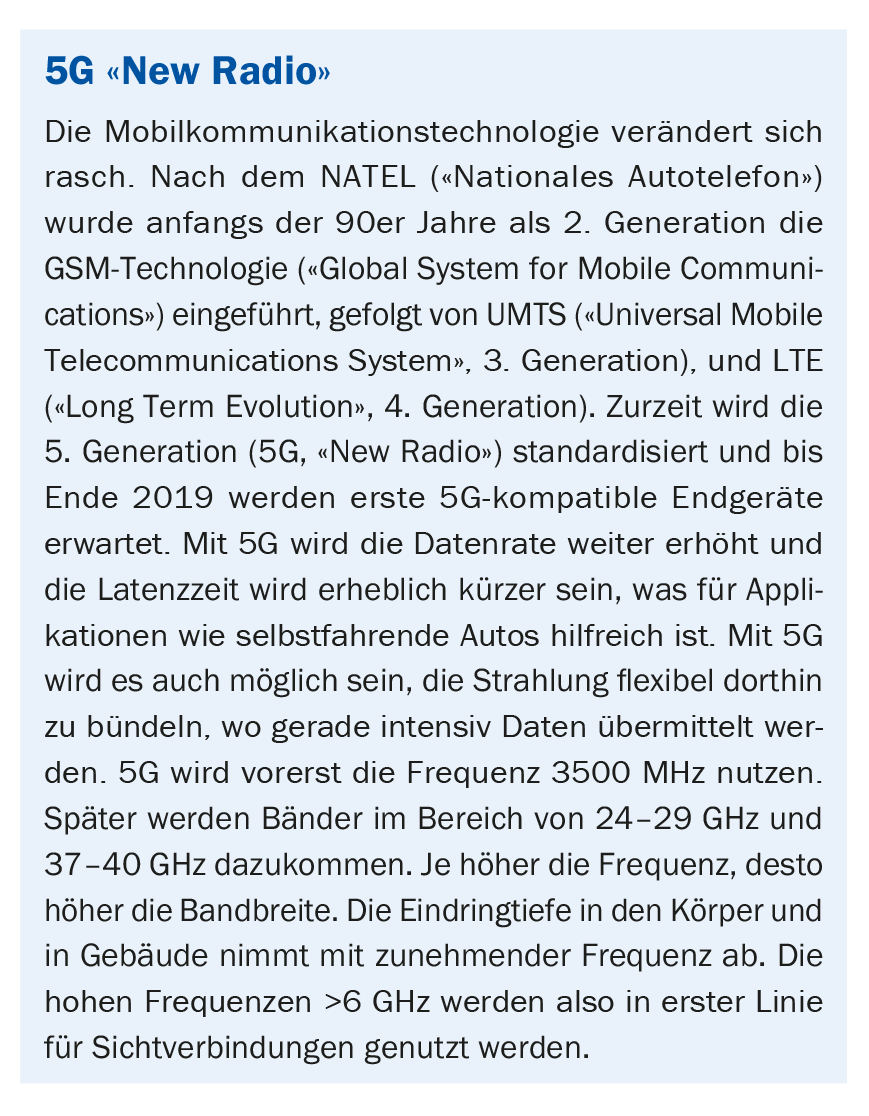
EMF in the medical practice
There are no diagnostic criteria for patients who attribute their complaints to EMF [11]. Therefore, it is hardly possible to prove causality in individual cases, although this aspect is often in the foreground for EMF patients. Experiences with EMF patients in the context of an environmental medicine consultation [12] show that it is more target-oriented to focus on the differential diagnostic aspects and the improvement of the health condition instead of the causality proof [13]. The challenge for the doctor is that the patient still feels taken seriously.
Patients often request measurements as well. These may be helpful if symptoms occur only in certain locations or if it is expected that a better knowledge of EMF exposure in the patient’s daily life will lead to an improvement of the situation. In this context, it is important to clarify the expectations of the measurement results and the questions precisely beforehand, since measured values without reference have little significance [13]. Overall, experience in recent years has shown that interdisciplinary environmental medicine consultation increases professionalism in dealing with environmental patients.
Take-Home Messages
- The majority of RF EMF dose comes from the use of body-worn devices such as mobile or cordless phones. There is evidence for biological effects at high exposures (e.g. cell phone near the head: increase of reactive oxygen species, changes in brain waves).
- The International Agency for Research on Cancer (IARC) classified HF-EMF as a possible carcinogen (Group 2B) in 2011. To date, however, no increase in brain tumors has been detected worldwide.
- Acute complaints from RF-EMF have not been demonstrated in double-blind randomized laboratory studies, and the few longitudinal epidemiologic studies find no evidence for long-term effects.
- When dealing with EMF patients, it is recommended to focus on differential diagnosis and treatment of the complaints and not to give too much weight to the causality question – although often important for the patients.
Literature:
- Kühn S, Kuster N: Field Evaluation of the Human Exposure from Multiband, Multisystem Mobile Phones. IEEE Trans on EMC 2013; 55(2): 275-287.
- Röösli M, et al: Personal measurements of radiofrequency electromagnetic fields in a population sample in the canton of Zurich 2016. Report commissioned by the Office for Waste, Water, Energy and Air (AWEL) in Zurich. www.awel.zh.ch, last accessed 21 Jan 2019.
- Frei P, et al: Temporal and spatial variability of personal exposure to radio frequency electromagnetic fields. Environ Res 2009; 109(6): 779-785.
- Lauer O, et al: Combining near- and far-field exposure for an organ-specific and whole-body RF-EMF proxy for epidemiological research: A reference case. Bioelectromagnetics 2013; 34: 366-374.
- Hug K, et al: Assessment of the evidence for biological effects of low-level radiofrequency radiation. Report commissioned by the Federal Office for the Environment (FOEN) Bern 2014. www.bafu.admin.ch, last accessed 21 Jan. 2019.
- Baan R, et al. (on behalf of the WHO International Agency for Research on Cancer Monograph Working Group): Carcinogenicity of radiofrequency electromagnetic fields. The Lancet Oncology 2011; 12(7): 624-626.
- Röösli M, et al: Brain and salivary gland tumors and mobile phone use: evaluating the evidence from various epidemiological study designs. Ann Rev Public Health 2019; 40: doi.org/10.1146/annurev-publhealth-040218-044037 [in press].
- Huss A, Röösli M: Consultations in primary care for symptoms attributed to electromagnetic fields. A survey among general practitioners. BMC Public Health 2006; 6: 267.
- Augner C, et al: Acute effects of electromagnetic fields emitted by GSM mobile phones on subjective well-being and physiological reactions: a meta-analysis. Sci Total Environ 2012; 424: 11-15.
- ANSES: Hypersensibilité électromagnétique ou intolérance environnementale idiopathique attribuée aux champs électromagnétiques. Paris: Agence nationale de sécurité sanitaire de l’alimentation, de l’environnement et du travail (ANSES) 2018. www.anses.fr, last accessed Jan. 21, 2019.
- Hug K, Röösli M: Electromagnetic hypersensitivity. Evaluation of scientific studies. Status at the end of 2011. Bern: Federal Office for the Environment 2012. www.bafu.admin.ch/publikationen, last accessed Jan. 21, 2019.
- Röösli M, et al: Environmental medicine consultation network of family physicians: a Swiss pilot project. Environmental Medicine in Research and Practice 2011; 16(3): 123-132.
- Physicians for Environmental Protection: Environmental Health Consultation, www.aefu.ch/themen/umweltmed-beratung, last accessed Jan. 21, 2019.
HAUSARZT PRAXIS 2019; 14(2): 41-44





